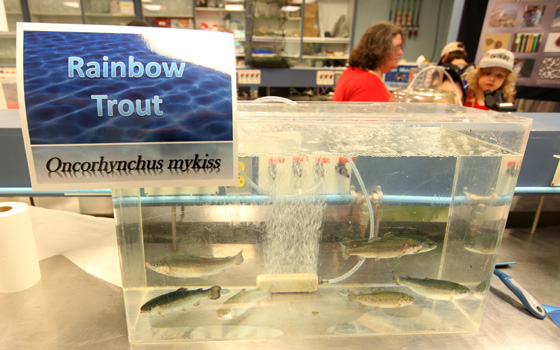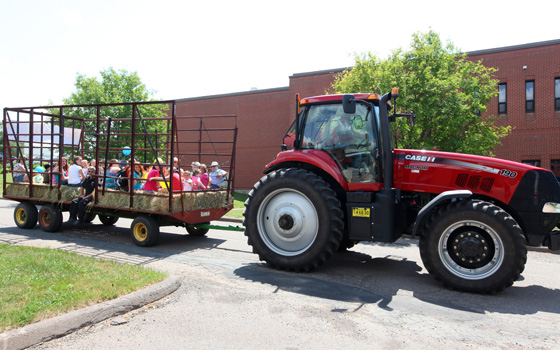For the faculty and staff who made their way to Bible Hill on the AVĺ„ņ÷≤Ņ bus last Thursday, it was hardly another day at the office.
You’re probably not going to be shearing sheep in Halifax, after all. Or having an in-depth conversation with a falconer, whose birds of prey protect a campus of bio-food crops from unwanted avian visitors. Or learning about world leading research to grow stronger potatoes and Christmas trees that are climate- and pest-resistant.
These are the sorts of experiences that make Nova Scotia Agricultural College unique, and this September they‚Äôre poised to become a key part of the AVĺ„ņ÷≤Ņ experience as well. The two universities are about to embark on an exciting new chapter of research and innovation together, with NSAC becoming Dal‚Äôs Faculty of Agriculture and the university‚Äôs Agricultural Campus.
See also:
Each year, NSAC throws out the welcome mat to the entire Truro/Bible Hill community at its Open House, opening its doors to families, friends and community members of all stripes ‚Äď including Tiger stripes.

The AVĺ„ņ÷≤Ņ Tiger himself, in fact, was along for the trip, helping Dal employees hand out Tiger Tail-flavoured ice cream and greeting kids with hugs alongside Rocky the Ram, NSAC‚Äôs mascot. Other faculty and staff on the trip spent their time on guided tours, walking through the spectacular gardens and checking out exhibits in each of the campus‚Äô research centres.
Research that connects with community
Though I‚Äôd spent time at NSAC before, it was always task-focused and fleeting, so Open House was a great opportunity for me to learn more about the research and scholarship that will soon become part of the AVĺ„ņ÷≤Ņ community. From the Plant Sciences teams set up in the Cox Building, to Aquaculture in the Haley Institute, to the barns of the Ruminant Animal Centre and the Atlantic Poultry Research Centre, nearly ever corner of campus was filled with excited students and faculty eager to share how their work makes a real difference to the agricultural community in Nova Scotia, the Maritimes and beyond.
For example, Zhuhui Ye, a masters student in aquaculture, told me about his lab’s research on the striped bass, a threatened species which spawns in the Shubenacadie River. With a natural gas plant set to begin construction nearby, the lab will be working with the gas company to monitor salt levels in the river, ensuring the bass’ spawning habitat remains viable. There were also plenty of other sea and river creatures on display, from rainbow trout to an elusive blue lobster.

Over in Plant Sciences, I talked with PhD student Sanghyun Lim about his genetics work on potatoes. ‚ÄúFarmers often use lots of chemicals to kill fungi, but those chemicals can include toxins,‚ÄĚ he explained. His team is working on growing potatoes with built-in residence to threatening fungi, limiting the need for these chemicals. I also had an extremely informative chat with Rachel Kennedy and Ernest Korankye of NSAC‚Äôs renowned Christmas Tree Research Centre, which is the only Christmas tree research centre in the world focusing on Balsam Firs. Part of their work is finding ways to keep trees lasting longer once they‚Äôre cut.
Not all of the NSAC researchers I talked to are doing strictly scientific projects. Jaclyn Mosher, with the Rural Research Centre, is the coordinator of the Wool Value Chain Development Project. She’s working with a wool mill in North River to determine the viability of insulation sales as a secondary revenue stream for farmers, since a great deal of sheep wool that can’t be used for clothing simply gets thrown out. And I spoke with two engineering students working on a rather awesome looking precision fertilizer spreader that not only uses a computerized map, but a real-time sensing and control system that can distinguish between weeds, bare spots and plants, and fertilize accordingly.
The spirit of the occasion
Of course, no trip to NSAC would be complete without visiting the barns. I got to watch young kids gleefully get into a ‚Äúbaaa-ing‚ÄĚ contest with sheep, and then be entertained as said sheep were given new summer haircuts. I watched while guests put their hands inside a live cow‚Äôs stomach to see what constitutes a bovine breakfast‚ÄĒit was more cool than gross, trust me‚ÄĒand saw others carefully handle a group of newly-hatched baby chicks.
Walking back to the centre of campus, through the Rock Gardens (okay‚ĶI cheated and took the tractor ride part of the way), I couldn‚Äôt help but note the energy that seemed to fill the campus. Surely, the fact that it was the perfect day for this sort of event helped a great deal‚ÄĒsunny skies, a slight breeze, ideal for walking around and exploring‚ÄĒbut it was more the spirit of the occasion: a university-wide effort to be open, accessible and connected with community. Open House may only be one day a year, but it was clear that this spirit flowed deep through the efforts of students, faculty and staff at NSAC.
It‚Äôs a spirit that will fit right in as part of AVĺ„ņ÷≤Ņ.
See also:


